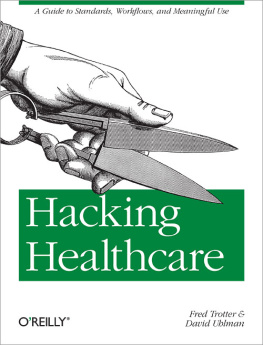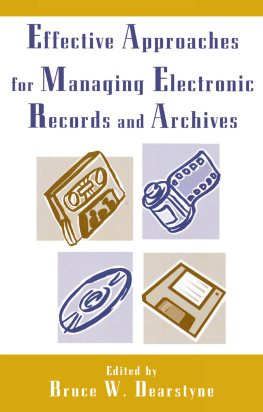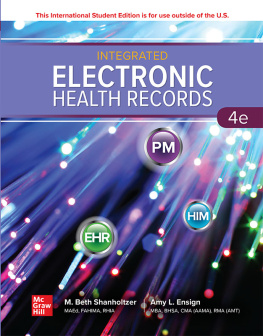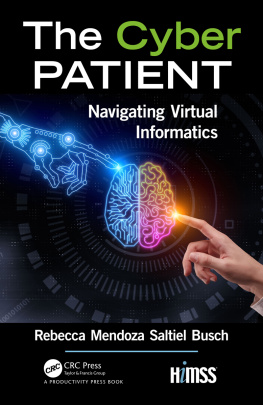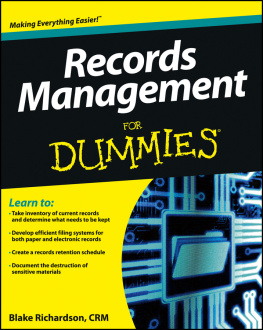Fred Trotter and David Uhlman - Hacking Healthcare
Here you can read online Fred Trotter and David Uhlman - Hacking Healthcare full text of the book (entire story) in english for free. Download pdf and epub, get meaning, cover and reviews about this ebook. year: 2011, publisher: OReilly Media, genre: Romance novel. Description of the work, (preface) as well as reviews are available. Best literature library LitArk.com created for fans of good reading and offers a wide selection of genres:
Romance novel
Science fiction
Adventure
Detective
Science
History
Home and family
Prose
Art
Politics
Computer
Non-fiction
Religion
Business
Children
Humor
Choose a favorite category and find really read worthwhile books. Enjoy immersion in the world of imagination, feel the emotions of the characters or learn something new for yourself, make an fascinating discovery.
- Book:Hacking Healthcare
- Author:
- Publisher:OReilly Media
- Genre:
- Year:2011
- Rating:3 / 5
- Favourites:Add to favourites
- Your mark:
- 60
- 1
- 2
- 3
- 4
- 5
Hacking Healthcare: summary, description and annotation
We offer to read an annotation, description, summary or preface (depends on what the author of the book "Hacking Healthcare" wrote himself). If you haven't found the necessary information about the book — write in the comments, we will try to find it.
Hacking Healthcare — read online for free the complete book (whole text) full work
Below is the text of the book, divided by pages. System saving the place of the last page read, allows you to conveniently read the book "Hacking Healthcare" online for free, without having to search again every time where you left off. Put a bookmark, and you can go to the page where you finished reading at any time.
Font size:
Interval:
Bookmark:

Beijing Cambridge Farnham Kln Sebastopol Tokyo
for more information on this offer!
Please note that upgrade offers are not available from sample content.
] These recruits to healthcare will bring valuable lessons learned through work in online commerce sites, financial institutions, or large corporate and university campuses, but they will be fundamentally bewildered during their first year or so at a hospital or clinic.
Meaningful use is the focus of this book because it is the term used in the Health Care Reform and Health IT Stimulus Act (HITECH, part of the American Recovery and Reinvestment Act of 2009) to encompass a vision of improved healthcare through computerization and digital networks. Theres a great deal of nervousness among U.S. healthcare providers about meaningful use. Can they push their organizations into the twenty-first century vision it represents? Will their IT systems really support it, and even if certified for meaningful use this year, will the systems support it in the future? And even if hospitals and clinics adhere to the letter of the law, will they really reap the benefits promised by health IT?
So meaningful use, for us, stands for much more than a set of requirements in a particular set of U.S. regulations. It represents a form of care that empowers the patient, that does not harm her, that promotes long-term health, and that is affordable for everyone. To realize this vision, IT staff in hospitals and clinics have to understand how their particular institutions work and what roles they play.
This book, so far as we know, is the first candid attempt to bridge the gap between clinicians and IT staff. It explains the factors that make healthcare settings different from other jobs and academic settings that computer staff may have come fromand that make the healthcare settings different from each otherso that readers enter these settings with a deep respect for their practices. We will not be reticent about sources of resistance to new computing opportunities. But we will give you a starting language for discussing the path to and beyond meaningful use.
We dont delve too deeply into technical details here, because they are fast changing. If we explained how to set up S/MIME for a direct email gateway, you might find that better options already exist when you get into the workplace. If we explained how to interact with the fields of a CCD, you would probably find that these fields are undergoing constant change and that much of the data you deal with requires a different format. So this is a different type of technical book: a book that gives you a context for choosing and implementing the right technology for your organization.
Weve directed our writing mostly at computer professionals, but this book can still be valuable for doctors, other clinicians, and other staff at healthcare institutions as well. We occasionally use terms from computer science and programming that will be familiar to people from those fields and might not be known to other readers. But we think that even the general reader can skip over technical details that he or she doesnt understand, and learn a lot about how to talk to other people about computers and networking in healthcare.
The chapters in this book are as follows.
An overview of the topics of this book, a discussion of differences between medical settings, and an overview of meaningful use, which will be fleshed out later in the book
The wide variety of ways healthcare settings deal with patients and staff, and how workflows vary
A candid investigation into how providers charge for care and how they get paid
An explanation of how deeply embedded paper records are in U.S. clinical settings, and what you need to do to migrate to electronic records
A review of what happens just outside the doors of the treatment room where administrative and IT staff perform traditional business operations
A detailed look at how patients can use technology to become participants in their own care, including such notions as personal health records, online communities, and the quantified self
A discussion of the most pressing problem in healthcare: avoidable errors, and how electronic records can both help and exacerbate the problems
A concise breakdown of the requirements for becoming meaningful use compliant
It is not possible to cover every important event in the history of a technology, but this discusses some of the highlights.
Vocabularies, jargon, classification systems for diseases and treatments, and other elements of making sense of information
A review of the technologies to exchange electronic healthcare records and the processes and systems that enable the process
When is health data covered under HIPAA, and what does that mean for your technology deployments?
Several comprehensive and fully featured systems exist to permit meaningful use compliance while using only open source software; these offerings provide an important reference and public resource for understanding meaningful use in technological terms or for real-world use
A checklist to help you determine how close your institution is to becoming meaningful use compliant
The following typographical conventions are used in this book:
Indicates new terms and emphasis.
This icon indicates a warning or caution.
This book is here to help you get your job done. In general, you may use the code in this book in your programs and documentation. You do not need to contact us for permission unless youre reproducing a significant portion of the code. For example, writing a program that uses several chunks of code from this book does not require permission. Selling or distributing a CD-ROM of examples from OReilly books does require permission. Answering a question by citing this book and quoting example code does not require permission. Incorporating a significant amount of example code from this book into your products documentation does require permission.
We appreciate, but do not require, attribution. An attribution usually includes the title, author, publisher, and ISBN. For example: Hacking Healthcare by Fred Trotter and David Uhlman (OReilly). Copyright 2013 Fred Trotter and David Uhlman, 9781449305024.
If you feel your use of code examples falls outside fair use or the permission given above, feel free to contact us at .
Safari Books Online is an on-demand digital library that lets you easily search over 7,500 technology and creative reference books and videos to find the answers you need quickly.
With a subscription, you can read any page and watch any video from our library online. Read books on your cell phone and mobile devices. Access new titles before they are available for print, and get exclusive access to manuscripts in development and post feedback for the authors. Copy and paste code samples, organize your favorites, download chapters, bookmark key sections, create notes, print out pages, and benefit from tons of other time-saving features.
OReilly Media has uploaded this book to the Safari Books Online service. To have full digital access to this book and others on similar topics from OReilly and other publishers, sign up for free at http://my.safaribooksonline.com.
Font size:
Interval:
Bookmark:
Similar books «Hacking Healthcare»
Look at similar books to Hacking Healthcare. We have selected literature similar in name and meaning in the hope of providing readers with more options to find new, interesting, not yet read works.
Discussion, reviews of the book Hacking Healthcare and just readers' own opinions. Leave your comments, write what you think about the work, its meaning or the main characters. Specify what exactly you liked and what you didn't like, and why you think so.

